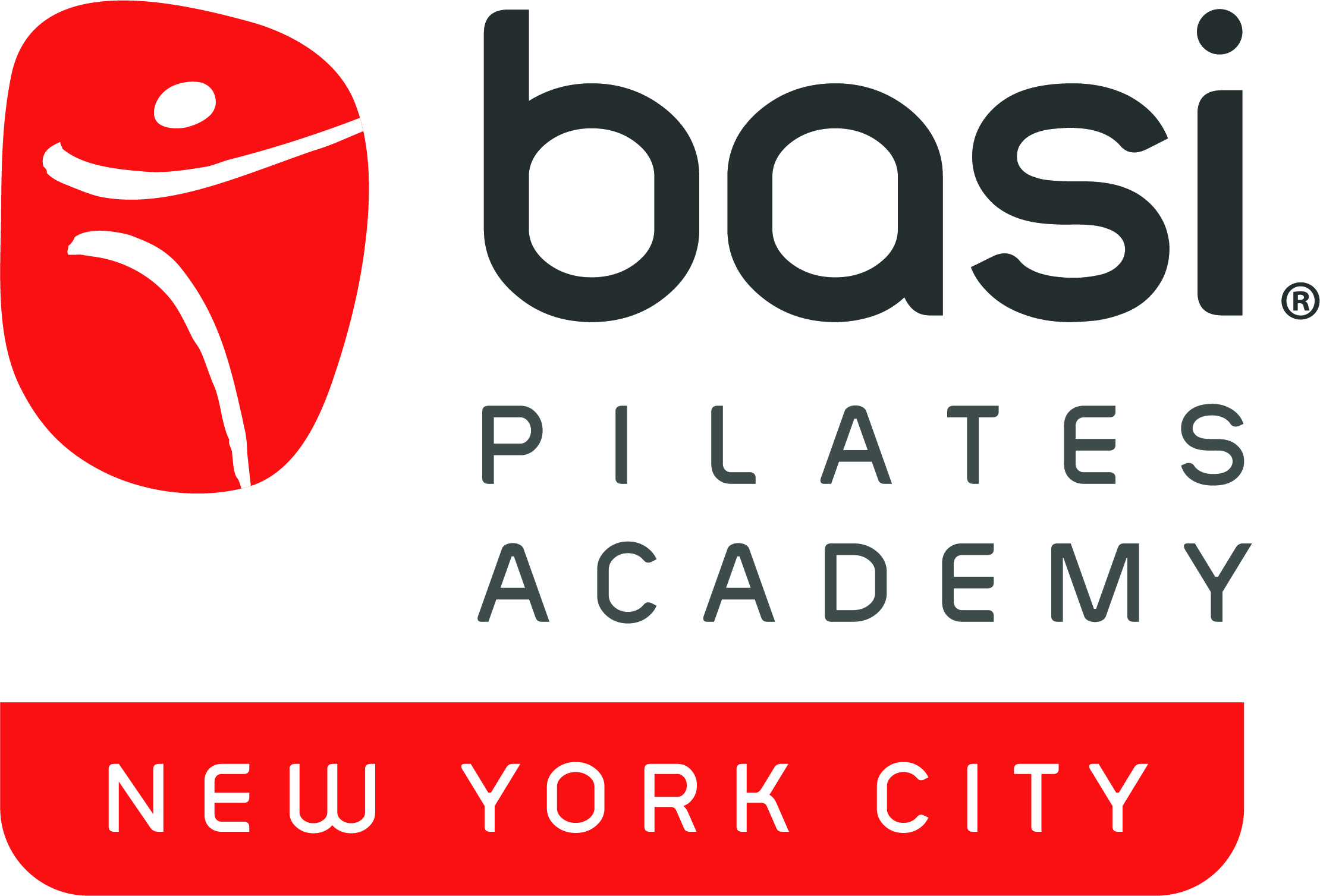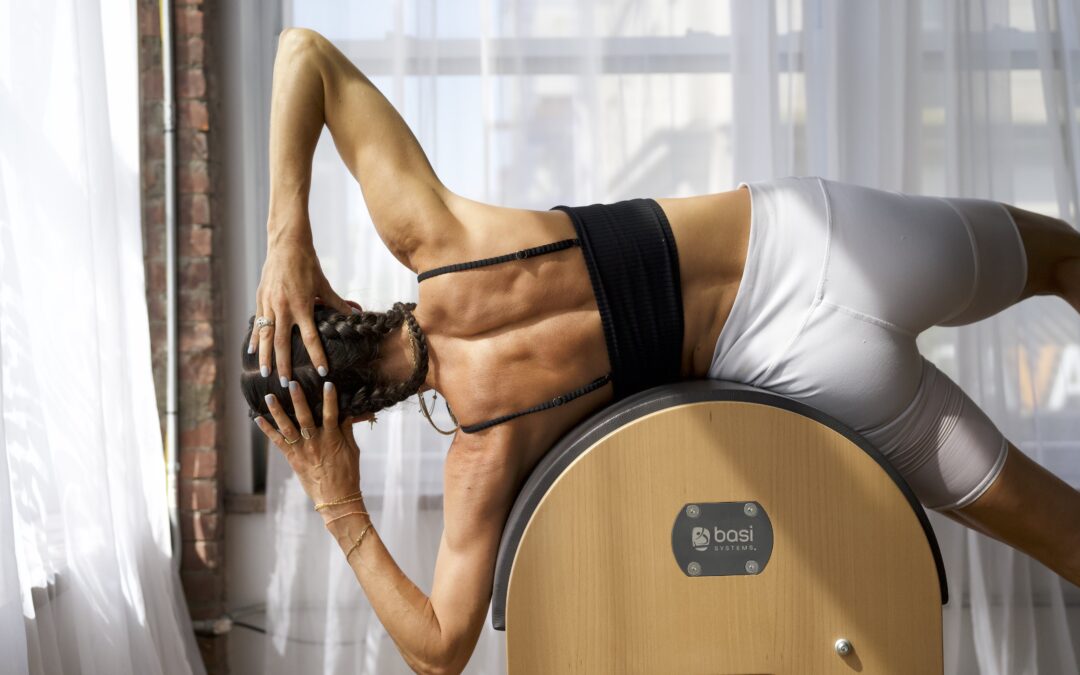Lawyers, tech workers, finance professionals, and creatives walk into studios across Brooklyn with the same telltale signs: rounded shoulders, forward head position, and complaints of neck pain, headaches, and tight upper backs. This is the Technology Posture Epidemic—a modern movement crisis affecting millions of desk workers, especially in New York City where long hours and demanding careers are the norm.
Poor posture isn’t a character flaw or laziness. It’s a predictable adaptation to spending 8-12 hours a day hunched over a screen. The good news? It’s reversible through intelligent movement retraining.
The Anatomy of Tech Posture
After nearly two decades at BASI Pilates Academy NYC, the progression is clear and predictable. A slight forward lean to read a screen becomes habitual. The head shifts just a few inches ahead of the shoulders. Over months and years, the body adapts, creating a cascade of structural changes.
Forward Head Posture: For every inch the head moves forward from neutral, it adds approximately 10 pounds of stress to the neck and upper back. A head position just 3 inches forward—common for desk workers—creates an extra 30 pounds of load the neck must support constantly.
Rounded Shoulders: Reaching toward keyboards and mice shortens the pectoralis muscles while overstretching and weakening the rhomboids and middle trapezius. This imbalance pulls the shoulder blades forward and away from the spine.
Thoracic Kyphosis: The upper back rounds excessively as vertebrae adapt to habitual positioning. This restricts full breathing capacity as the ribcage loses its ability to expand optimally.
Hip Flexor Tightness: Extended sitting keeps hip flexors in a shortened position. Over time, these muscles actually shorten, leading to lower back discomfort and difficulty standing fully upright.
Gluteal Amnesia: The glutes essentially “forget” how to engage from prolonged sitting, shifting the burden of hip stability and spinal support to muscles never designed for that role.
The result? A body perfectly adapted to sitting at a desk but struggling with everything else—walking, exercising, even sleeping comfortably.
Why Common Solutions Fall Short
Most responses to tech posture pain rarely address root causes:
Willpower-based correction: “Sitting up straighter” creates excessive tension through the neck and shoulders. It’s exhausting and unsustainable. True postural change requires retraining deep stabilizing muscles to work automatically.
Ergonomic equipment: Better chairs, standing desks, and monitor setups help, but don’t retrain movement patterns. Expensive ergonomic chairs can’t fix bodies that have lost the capacity to maintain upright posture without excessive effort.
Stretching alone: Stretching provides temporary relief but doesn’t address the strength deficits and motor control issues driving poor posture. Weak, inhibited muscles can’t be stretched into function.
Massage: While massage releases tight muscles temporarily, those muscles tighten right back up without addressing underlying weakness and poor movement patterns. Even working alongside exceptional massage therapists at the clinic, the pattern repeats—massage alone isn’t enough.
These approaches aren’t bad; they’re incomplete. What’s missing is intelligent movement retraining that addresses the entire system.
The Pilates Solution: Movement Intelligence
BASI Pilates Academy NYC approaches tech posture as a movement problem, not just a structural one. Bodies have learned to move in specific patterns over years of desk work. The solution is teaching better patterns through intentional, intelligent movement training.
The BASI approach differs from conventional exercise by retraining the nervous system, not just strengthening muscles, to support the body in a more organized, efficient way throughout daily activities.
Scapular Stability Training: Before improving shoulder position, the shoulder blades need to learn proper movement and stabilization. This involves retraining the serratus anterior, rhomboids, and lower trapezius to work in coordination. Exercises like the Arm Series on the Reformer and scapular work on the Cadillac restore proper shoulder blade mechanics.
Thoracic Extension Mobility: Rounded upper backs need to regain extension ability—not forcing the spine into an uncomfortable arch, but restoring natural, healthy movement through thoracic vertebrae. Exercises encourage segmental spinal articulation, allowing each vertebra to contribute.
Deep Neck Flexor Strengthening: The front neck muscles that hold the head in proper alignment often become weak and inhibited in forward head posture. Subtle but powerful exercises teach the head to stack properly over the shoulders without strain.
Hip Flexor Lengthening with Control: Rather than passive stretching, hip flexors learn to work eccentrically—maintaining engagement while lengthening. This creates functional flexibility for standing and walking.
Posterior Chain Activation: The entire back body—glutes through spinal extensors—needs to wake up and coordinate. The BASI Block System systematically addresses all these areas in every session.
Real Results from Systematic Training
A Manhattan corporate lawyer arrived after years of chronic neck pain and tension headaches. Physical therapy, massage, even Botox injections provided no lasting relief.
The pattern was clear: head living 4 inches forward, excessively rounded upper back, almost no awareness of shoulder blade position. Asked to “stand tall,” she immediately hyperextended her lower back and lifted her ribs—tension in completely the wrong places.
Training started with basic awareness work. Before adding strengthening, she needed to feel where her head actually was in space and where it could be. Simple movements—small head nods, gentle shoulder blade glides—helped her nervous system register new possibilities.
Over several months, these new patterns were progressively challenged. Training moved from basic mat work to exercises on the Reformer and Cadillac, requiring maintained alignment while adding resistance and complexity. The key wasn’t working harder but working smarter, with precision and intention.
Six months later, headaches were gone. She stood differently, moved differently, worked long days without the same discomfort. The real transformation was awareness—she could feel when slipping into old patterns and had tools to self-correct.
The BASI Block System Advantage
The BASI Block System, created by founder Rael Isacowitz, ensures every session addresses all movement planes and muscle groups. Sessions aren’t random exercises or trendy movements. Each is structured to include:
- Stretch Block: Addressing shortened, tight muscles pulling the body into poor posture
- Strengthening Blocks: Building strength in weakened, overstretched muscles
- Spinal Articulation: Restoring segmental mobility throughout the entire spine
- Integration: Teaching the body to maintain better alignment during functional movements
This comprehensive approach addresses all factors contributing to tech posture simultaneously, creating faster and more lasting change.
Beyond the Studio: Daily Integration
Pilates sessions 2-3 times weekly provide the foundation, but lasting improvement requires daily awareness:
Microbreaks Every 30 Minutes: Standing, walking, simple movements—even 60 seconds helps reset position and prevent tension accumulation.
Desktop Exercises: Seated spinal rotations, shoulder blade squeezes, neck stretches keep the body moving throughout the workday.
Walking Awareness: Notice posture during commutes or walking to meetings. Leading with the head or stacking the body vertically? Small adjustments reinforce studio learning.
Breath Breaks: Five deep breaths several times daily, focusing on ribcage expansion in all directions, counteracts shallow chest breathing and maintains thoracic mobility.
Evening Practice: Even 10-15 minutes of mat work helps undo postural stress and reinforces better patterns.
The Neurological Component
Tech posture isn’t just about tight or weak muscles—it’s about habitual patterns the nervous system executes automatically. Every time someone sits at a desk, the brain follows a familiar motor program: shoulders round, head shifts forward, chest collapses. These patterns become so ingrained they happen unconsciously.
Changing them requires more than strength—it requires reprogramming automatic patterns. The precision and awareness emphasized in Pilates creates new neural pathways. Moving slowly and mindfully, paying attention to exactly how movement is initiated and controlled, establishes these pathways. Over time, new patterns become automatic, replacing old ones.
Research shows motor learning requires repetition, attention, and variation—exactly what Pilates sessions provide. Each exercise practices better alignment and movement patterns in slightly different contexts, helping the nervous system generalize improvements to daily life.
Common Misconceptions
“Core strength is the solution”: While core strength matters, tech posture is about the relationship between head, ribcage, and pelvis. Strong abs don’t guarantee good posture if alignment and movement patterns are off.
“Yoga will fix it”: Yoga can be wonderful, but many practitioners reinforce tech posture by rounding forward in poses without specific attention to scapular mechanics and deep postural muscles.
“It’s just aging”: Students in their 60s and 70s who invest in intelligent movement training often move with more ease and better posture than 30-year-olds. Age is a factor, not destiny.
“No time”: Time is already spent managing pain and dealing with poor posture consequences. Pilates is a more efficient investment addressing causes rather than symptoms.
Taking the First Step
The average desk worker spends about 2,000 hours per year sitting. That’s 2,000 hours reinforcing patterns that cause pain, limit movement, and prematurely age the body.
Spending just 2-3 hours per week—less than 0.1% of total time—actively training better patterns yields enormous returns: less pain, better energy, improved breathing, and a body that actually provides support through demanding days.
Brooklyn clients initially come for pain relief but stay because they discover physical competence and ease they haven’t felt in years. That’s the real benefit of addressing tech posture intelligently.
BASI Pilates Academy NYC specializes in helping desk workers and professionals reclaim posture, movement, and physical ease. Private sessions and small group classes at the Brooklyn studio address these specific issues through thorough movement assessments and progressive programs tailored to individual needs.
Book an initial consultation at BASI Pilates Academy NYC and start the journey from desk warrior to movement master.
Lynda Salerno Gehrman is the owner and founder of BASI Pilates Academy NYC (formerly Physio Logic Pilates & Movement), which she established in 2006. She holds a BA in Dance Performance/Composition and has been a Pilates student for over 20 years and teacher for 18+ years, beginning her Pilates journey at age 15. Lynda studied under esteemed European Pilates teacher Alan Herdman in London and now serves as assistant faculty for BASI Pilates Teacher Training. The Brooklyn studio collaborates with Physio Logic, a multidisciplinary medical and wellness center.

